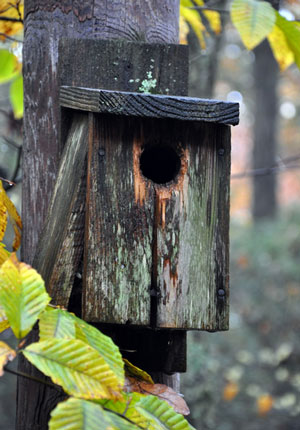Birds are among the most beautiful creatures on Earth. With their social behavior, mellifluous songs and vivid colors, it’s not surprising that so many people around the world have birdhouses and bird feeders in their yard.
Attracting birds to your yard can be a fun and relaxing experience, but when you do, it’s also your responsibility to make sure they’re safe and healthy. Below, you’ll find everything you need to know about cleaning out birdhouses and step-by-step instructions for how to do so.

Why You Should Clean Birdhouses
Cleaning out a birdhouse, also known as a nesting box, may not seem necessary since you’ll often see old bird nests underneath awnings or hidden in mailboxes.
Some bird species, like Eastern Phoebes, will also reuse their nests year after year. However, there are some compelling reasons why you should clean out your birdhouses.
The first and most important reason you should clean out your birdhouse is to prevent any diseases, fungus or bacteria from living inside. Even if it’s empty, when a bird comes back to make its nest, many diseases will spread to nesting birds and kill a mother and its young.
Aside from bacteria, larger creatures like rodents and insects may also take up residence. Leaving old nesting material in there will only make the nesting box more appealing to critters.
A second reason to give it a thorough cleaning is that it will make it more appealing to birds. While some birds will reuse a nest from the previous year, the vast majority of species that use birdhouses as nesting boxes will not. Cleaning out your birdhouse is like changing the sheets on the bed before a new guest comes to your house — it’s common courtesy and will keep your guests coming back every year.
How Often You Should Clean Birdhouses

You know why you should clean out your birdhouses, but now it’s time to look at how often. The simple answer is at least once a year, but a good rule of thumb is to clean it after a brood has fledged and left the nest. The reason for this is that it will give other birds the chance to take up residence and it prevents any bacteria from staying.
For species that breed several times a season like bluebirds, it’s equally important to clean out the feeders between every brood because it will reduce the possibility of nest parasites like feather mites that wreak havoc. You can find out more about how often certain species breed in a season at our common birds nesting guide.
Before cleaning out a nest in the middle of breeding season, it’s always vital to make sure the birds have completely departed, so you don’t disturb an active nest. Start by monitoring the birdhouse over the course of a few days to see whether there’s any activity. If there isn’t any, you can give a gentle tap on the sides of the birdhouse. If you don’t hear chirping inside, it’s likely empty and ready to be cleaned.
How to Clean a Birdhouse
- Start off by getting some gloves, a bucket, water and bleach.
- Take down the birdhouse and open it up to gain access to the inside. Most birdhouses, like this one from Nature’s Way, have some sort of hatch or lever that allows you to thoroughly clean the inside of a birdhouse.
- Remove the old nest with your gloves on because it may contain parasites. Discard everything inside the nest into a sealable trash bag. Don’t try to save anything for an arts and crafts project because the materials are likely dirty and could be contaminated.
- Get a scraper and scrape out any gunk or fecal matter that may have accumulated over the nesting period.
- Create a dilute bleach solution of one part bleach to nine parts water in the bucket.
- Give the birdhouse a good scrubbing with the solution, making sure to get all corners and crevices.
- Completely rinse out all traces of the bleach solution with water. It may be a good idea to leave the hose running over it for a minute or rinse it off several times to make sure all the bleach is gone.
- Place the birdhouse in direct sunlight and let it air dry for several hours to ensure that no water is inside. This will help prevent the growth of mold and mildew.
- After it’s clean and dry, give it a nice inspection to make sure nothing broke or came unhinged during the cleaning process.
- Securely put the feeder back up and you’re all set.


